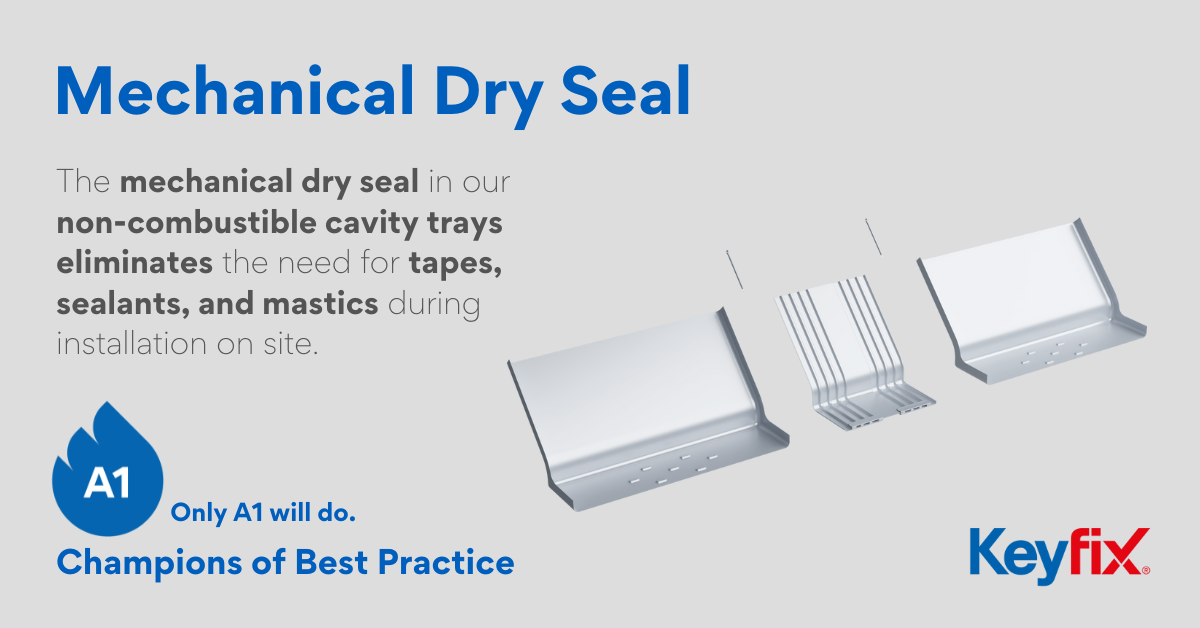
Champions of Best Practice

Posted on 05 Jul 2023
Read Keyfix Managing Director, John Duffin’s latest blog on preventing water ingress by incorporating a unique mechanical dry seal joint in Keyfix’s Non-combustible Cavity Tray system.
Joint failures in DPCs and Cavity Trays are every Developer’s, Warranty Provider’s and Brickwork Contractor’s worst nightmare. Water leaking through a building’s masonry can create a myriad of problems for a building and its residents. Although many accept water ingress as an occupational hazard, it is a problem that can be avoided from the initial stages of construction. As champions of best practice, Keyfix believes that the risk of water ingress through joint failure is something that should be designed out from the very beginning of a project. Keyfix discusses how its Non-Combustible Cavity Tray (NCCT) prevents water ingress with its unique mechanical dry seal.
Cited by one of the UK’s largest Warranty Providers as being “the single biggest reason for reopening the cavity wall of an occupied building”, failures in the joints of DPC’s and Cavity Trays were at the forefront of developing the unique mechanical dry seal that has propelled the Keyfix NCCT system to the top of its class. Known industry-wide as the most engineered and robust solution in the Non-Combustible Cavity Tray sector, Keyfix knew that we needed to eliminate the root cause of the problem causing the failure of these joints – the use of tapes, sealants, and mastics.
Whilst these products are used successfully in everyday construction, they are more commonly used where they can be maintained or replaced as and when required. Poor joint performance is rarely the fault of either manufacturer or installer but more the environment that they are being installed and combined in. Dust, moisture, and low temperatures, all of which occur in abundance on site, play havoc on a joint made using tapes, sealants, or mastic, and with no way of non-destructive testing of this type of joint, its no surprise that it turns up as a warranty provider’s number one issue.
Noticing these consistent issues in products, Keyfix set out to create a product that overcame the major design flaw associated with cavity trays. Keyfix designed its NCCT to be completely unique from other cavity trays, as it is the only market offering that does not rely on tapes, sealants, or mastics. Instead, the innovative design of the NCCT features a mechanical dry seal joint referred to as Ribbed Overlapping Joints. This mechanical dry seal joint is created when ribs formed by downward-pressed channels within the tray profile are completely overlapped by a brick tray.
The use of sealants, tapes, or mastics increases the possibility of onsite installation errors outside of both the manufacturer’s and the installer’s control and therefore the warranty. By eliminating the use of tapes, sealants, or mastics at joints, the Ribbed Overlapping Joint provides unrivalled joint integrity over the full lifespan of the building, not a notional 60 year period. Additionally, the Ribbed Overlapping Joints allow for real-time non-destructive joint quality confirmation and remove all installation errors associated with on-site conditions such as dust, moisture, or low temperatures, which prevents ‘wet’ joints from performing and subsequently prevents water ingress. This unique design allows the installer, or anyone else to check the joint integrity on site giving peace of mind to all concerned.
To provide proof of best practice, the Keyfix NCCT is an independently verified solution. The British Board of Agrément (BBA) has completed the following tests to ensure the mechanical dry seal at joint overlaps are sufficient and performs to the required performance within a wall: characteristic shear strength to BS EN 1052-4:2000, characteristic flexural bond strength to DD86-1:1983, and the effectiveness of water discharge test (0.45 Litres per minute per linear meter) which was carried out on a sample installation including external and internal corner details.
One common irony in the construction industry is the practice of specifying cavity trays which use sealants, mastics, and tapes in brick buildings, the brick façade is designed to last well beyond 100 years. Therefore, a 60 year lifespan of any unmaintainable component within the brick façade is at odds with using a brick exterior. Stainless steel has on the other hand numerous examples of its use fully exposed in harsh urban and coastal environments without any issues for over 100 years. As champions of best practice, Keyfix always encourages the industry to use products that perform safely and reliably to protect the buildings they form part of. The Keyfix NCCT and its innovative dry seal mechanism ensure that the building it is used in is protected against water ingress and the problems associated with it. This tried and tested design makes the Keyfix NCCT the reliable cavity tray the industry can have complete confidence in for the entire life span of a brick clad building.
Discover our latest CPD “Solving the non-combustible Challenge with Keyfix Cavity Tray systems”
Request CPDEnter your name and email address below to keep up to date with Keyfix product developments, CPDs, industry news and much more.